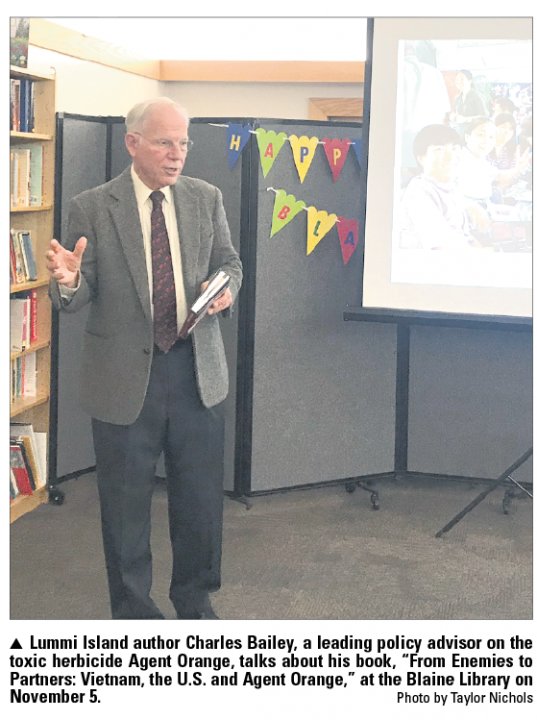By Taylor Nichols
For decades after the Vietnam war, the Vietnamese and U.S. governments were reluctant to address the problems caused by Agent Orange, the toxic herbicide sprayed all over Vietnam in the 1960s. Officials wouldn’t even say the words “Agent Orange.”
That’s slowly begun to change, due in large part to Lummi Island resident Dr. Charles Bailey, a public policy specialist who has spent nearly 20 years working to solve problems caused by dioxin, the dangerous chemical in Agent Orange.
“We know that modern wars have long shadows,” Bailey said. “And this is almost a classic example of what long shadows wars can cast on future generations who, after all, have to make their lives in former battlefields.”
 Bailey came to the Blaine Public Library on November 5 to talk about his book “From Enemies to Partners: Vietnam, the U.S. and Agent Orange.” In it, he and his co-author Le Ke Son delve deep into the realm of Agent Orange, discussing dioxin pollution cleanup, the effects of exposure still felt in Vietnam and steps both countries should take to move forward in a humanitarian response.
Bailey came to the Blaine Public Library on November 5 to talk about his book “From Enemies to Partners: Vietnam, the U.S. and Agent Orange.” In it, he and his co-author Le Ke Son delve deep into the realm of Agent Orange, discussing dioxin pollution cleanup, the effects of exposure still felt in Vietnam and steps both countries should take to move forward in a humanitarian response.
The two authors went to Vietnam in late September for a book tour following the recent release of the book in Vietnamese. The English version was published just over a year ago.
When Bailey moved to Hanoi in 1997 to work for The Ford Foundation he was shocked to find how long-lasting the effects of Agent Orange were and how little was being done to address it.
“This is like the fog of war continued long after the guns had fallen silent, and soldiers had left the field of battle,” Bailey said.
He set to work, allocating Ford Foundation grants to research where dioxin contamination was. They found dangerous levels were contained to three hot spots.
The identification of cleanup sites provided Vietnam and the US with a path forward. They could finally start addressing these issues by tackling a problem at hand.
“I tried to walk this very narrow path between these two polarized sides, the U.S. and Vietnam,” Bailey said. “It took me seven years to get to the point where I could actually say, ‘we have a breakthrough.’”
The first cleanup location was former Agent Orange storage site, Da Nang International Airport.
Just one day after the project concluded in November 2017, President Trump stepped out of Air Force One onto the tarmac of the now non-toxic airport for a summit meeting, Bailey said.
The next cleanup site will be dioxin hotspot Bien Hoa airport near Ho Chi Minh City. U.S. Secretary of Defense Jim Mattis met with Vietnamese officials last month and agreed to move forward with plans for a Bien Hoa cleanup, the clear next step in this partnership, Bailey said.
The rest of the conversation and funding provided by the US government is focused on helping severely disabled people in areas that were heavily sprayed in Vietnam.
Agent Orange exposure is linked with at least 14 different health problems and diseases, including cancers, diabetes, Parkinson’s Disease and birth defects. Millions of Americans and Vietnamese are still affected by it today, Bailey said.
“More and more people are realizing it’s a humanitarian concern we can do something about,” Bailey said. “You can’t change the past but you can recognize what happened and that’s the first step to a better future.”
While Vietnam veterans can get disability compensation and health care benefits if they suffer from diseases linked to dioxin, aid is limited for other Agent Orange victims. People who were in Vietnam during the war but were not in the armed forces, including journalists, government employees and their families, do not qualify, Bailey said. Children and grandchildren of exposed veterans may not qualify either, depending on what their health-related issues are.
Bailey has met many Agent Orange victims in Vietnam and the U.S. through his work. One such victim is Heather Bowser, the president of Children of Vietnam Veterans Health Alliance, an advocacy group that educates about the effects of Agent Orange on children of veterans. Bowser was born missing her right leg below the knee, missing parts of fingers and other physical deformities.
The organization has been pushing for program expansions to account for second and third generation victims of Agent Orange.
Bellingham resident and Vietnam veteran Chuck Anway, 72, served three and a half tours during the Vietnam War. He said he was exposed to Agent Orange on his last tour in Khe Sanh in 1971, sleeping in a military tent on ground saturated with the herbicide.
“He says, ‘I got killed in Vietnam. I’m just not dead yet,’” his sister, Margaret Wyngaert told the group at the library.
He’s developed several diseases linked with dioxin, including ischemic heart disease and diabetes. He receives disability compensation from the Veterans Association as a result.
“They pay me this ungodly amount of money because they don’t think I’m gonna live very long. It’s true. Sad but true,” he said. “They want to send you to war but they don’t want to take care of you when you come back.”
His kids all have medical problems, but none of them are identifiable as caused by dioxin, he said.
“We’re watching the grandkids real careful,” he said.
Comments
No comments on this item Please log in to comment by clicking here